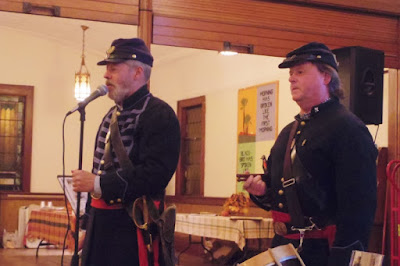The Civil War, said Jim Pace, was “a war of music.” Each company had to have two field musicians, one fifer and one drummer. The field musicians were called upon to play from early morning until late at night. They woke up the soldiers in the morning. On the battle field, the signals that they played told the soldiers what they were to do next. They were considered to be battlefield communication. There were 30 to 40 different signals that were played by the drums. Fifes did not play tactical commands. The commands included forward march, commence firing, cease fire, and march in retreat.
Sometimes, on the battlefield, the field musicians were called to play something inspiring and patriotic, especially if their army was being routed.
The extra musicians were called upon to perform other duties, such as carrying stretchers and assisting in surgery. Field musicians were designated as uniformed noncombatants. They carried ceremonial swords but most did not have any actual weapons.
Back at the camp, the field musicians played at all ceremonies, including dress parades and inspections by the commander, the president, etc.; funeral ceremonies; and the punishment ceremony.
Brian and Jim demonstrated songs that were played during each of the ceremonies. Ceremonial performances always began and ended with “three cheers.” At the dress parade, people might hear “Duke of York” and “The Old 1812.” These were upbeat and happy sounding songs. The funeral ceremonies featured more somber music, written in a minor key. The sad songs were followed by happier music. Unfortunately, funeral ceremonies happened very frequently. There was a “tremendous loss of life after battles,” Jim said. “Most casualties in the camp were not from battle wounds, but from disease.”
The punishment ceremony was performed when someone was caught for breaking rules, such as stealing. The convicted thief had his head shaved and his military insignia taken away. The fife and drum played the Rogue’s March. As the music was played, the culprit was marched to the end of the camp and was thrown out of the army. Literally. The drums were playing. That is where the expression “drummed out of the army” came from.

